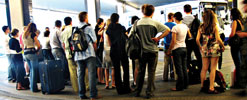

Airports around the world have been perhaps the largest adopters of network video over recent years as fears of terrorists, targeting either aeroplanes or airport buildings themselves, have risen steeply since the tragic events of 11 September 2001 in New York.
Network video is not only being used to identify and track suspicious individuals but also to prevent thefts, spot unaccompanied baggage and even to ward off personal injury claims.
Cameras are often placed at the entrances and exits to an airport terminal, recording who comes in and out 24-hours-a-day. This deters criminals and the footage can be used as evidence if a crime occurs. Cameras are also used to support airport security staff and customs officials as they go about their work to stop illegal immigration or smuggling, for example.
Hangars are increasingly monitored remotely via network video to ensure that aircraft are not tampered with between flights and during routine maintenance. Network video is also often deployed in airports’ baggage systems to ensure bags are not tampered with, stolen or handled inappropriately by baggage handling staff.
Network cameras are even being used to improve customer service by broadcasting up-to-the-minute images of incoming aeroplanes in the departure lounge, showing, for example, when a plane is ready to board.
As security has been tightened in many airports, more cameras have been deployed and security systems have been integrated into building management systems so that cameras can capture exceptional events such as fire exit doors being opened or bags being abandoned in a location for more than a few seconds. Intelligent video analytics can now be built into network cameras to highlight and zoom in on unaccompanied bags and send alerts to key individuals on their mobile devices, for example.
Trains and buses
Increasingly cameras are being deployed on train platforms, bus stops as well as inside train carriages and buses around the world. The perception that public transport is safe as well as clean, on time and affordable is critical if South Africans are going to be encouraged to leave their cars at home and use public transport. Achieving this goal is now possible through the use of network cameras. Network cameras are also being integrated with a range of alarm systems so if a person wanders onto a rail track this will immediately trigger an audible alarm in tunnels and relevant drivers will be informed automatically via a security control centre.
Network cameras are also available that are built specifically for deployment in moving vehicles. These new rugged cameras offer a vandal resistant housing which even has a built-in tamper alarm so that if it is obscured for any reason an alarm signal will be sent to a central security station. They have also been designed so that the lens can be adjusted for fixing on tilted surfaces.
Surveillance systems today need to offer:
* Higher quality images which can be used to positively identify individuals in a court of law.
* Easy, yet secure integration with wider range of intelligent applications, many of which lend themselves to communication over the network.
* Remote and/or centralised monitoring for more rapid and effective co-ordination to incidents and more robust storage of images.
In short, there is an increasing need for security solutions to be both more intelligent and effective to ensure people feel just as safe on the move as they are when they finally reach home. IP-Surveillance offers this possibility. This video link expands on this topic: http://www.axis.com/solutions/video/transportation/index.htm.
| Tel: | +27 11 548 6780 |
| Email: | [email protected] |
| www: | www.axis.com |
| Articles: | More information and articles about Axis Communications SA |
© Technews Publishing (Pty) Ltd. | All Rights Reserved.